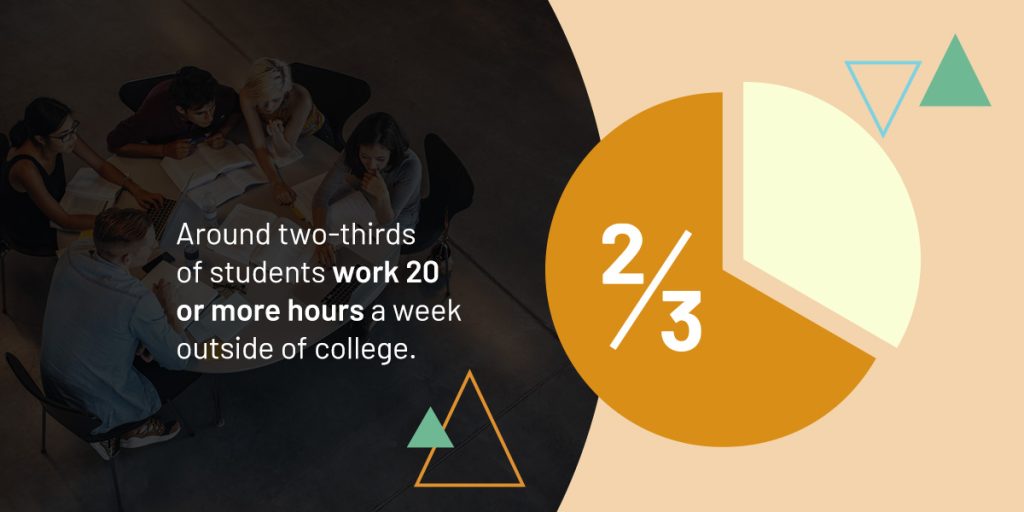
Community college students face various obstacles during their studies, sometimes leading them to drop out of college. Understanding community college student needs and providing essential support services can help them cope with their challenges and celebrate on graduation day.
Community college leaders must take a holistic approach beyond academics and look at other priorities, such as family, work, and mental health. A student-focused, data-driven, personalized student support strategy is essential to achieving successful outcomes for your students and your college. If your community college aims to enhance its student support program, this guide will help you optimize your support strategies.
The top 5 community college student challenges
In this day and age, community colleges find themselves in a unique territory. Increasing tuition fees and cost of living, technological advances in higher education, and a hypercompetitive job market are unique challenges that today’s students face. While each student is different, these challenges are prominent across community colleges in the country.
1. Affording tuition fees
Increasing tuition fees is a challenge in various higher education institutions. For years, community colleges have been an affordable option for underserved or low-income students. In 2022-2023, the average cost of attending a public two-year in-district institution was $3,598 per year.
While this cost is considerably lower than other higher education institutions, many community college students need financial aid to afford these fees. Enrolling in a community college is a financial commitment that can be overwhelming for students who need funds. Nearly a third of community college students who drop out say their decision was based on financial concerns.
2. Keeping up with technological advances
While technology is helping colleges make incredible strides in higher education, it also poses some difficulties for community college students. If the student is from an impoverished background, they may not have access to Wi-Fi. Lack of internet access makes it difficult for these students to access college resources online. Many of these students may also need laptops or desktop computers.
College websites, online resources, and platforms should be accessible to all students. Students with disabilities, lower literacy skills, and diverse backgrounds must be able to navigate your college’s online platforms. For example, text alternatives for video or audio files on your website make material accessible for students with hearing impairments. If a student has slow internet, they can read the text alternative instead of waiting for a video to load.
3. Balancing student life
The rising cost of meeting basic needs and paying tuition fees leads to many students having to work. While working helps students cover their expenses, many become overworked and need to play catch-up at college.

Around two-thirds of students work 20 or more hours a week outside of college. Students who work outside of school tend to achieve lower marks than those who don’t work and study full- or part-time. There is little time to rest when students are constantly on the go at work, attending lectures, or completing assignments.
Some students may also be parents, which means they balance caring for children, working, and studying. When students are balancing all of these demands, finding time to relax is challenging. The lack of rest only adds to the stress they experience.
4. Maintaining mental health
Students nationwide are contending with a mental health epidemic. Without adequate support, these students have difficulties realizing their potential and are at risk of disengaging from academic life. Community college student surveys reveal that 56 percent experience mental health or emotional problems resulting in academic challenges, while 37 percent believe their mental health struggles could lead them to drop out.
While mental awareness is improving, many students are unaware of the resources available, unsure when and how to seek help, and sometimes deterred by the lingering stigma around mental health issues in some social circles. Community colleges aiming to enhance student success and retention must prioritize bridging these gaps between their mental health resources and the students who need them.
5. Closing support gaps
Student support covers a broad terrain, and community college support resources must keep up with the needs of growing and diversifying student populations. Gaps are bound to emerge, disadvantaging students with underserved needs. The challenge for community colleges lies as much in recognizing the key gaps to close as it does in mobilizing the resources to close them. Common student support gaps include:
- Academic guidance, including course selection, tutoring, and study skills development.
- Career preparation and planning.
- Support for students who are parents or employed.
- Orientation to campus culture and student communities.
- Mobile-friendly systems for streamlined access to support.
Solutions to support the needs of students in community colleges
Community college leaders and support staff play a vital role in helping students achieve successful outcomes. Typically, students at community colleges come from diverse backgrounds. They may come from low-income households, be parents, or be a part of an underserved demographic — factors that make students vulnerable to dropping out of college. College staff can support students by bridging gaps and meeting students in their areas of lack.
1. Financial aid
Community college may be more affordable, but many students need financial assistance to enroll and complete their studies. Financial aid advising is a crucial support system that should be available to students. Financial advisors need to be there to help students make wise financial decisions. To ensure that students can stay enrolled and complete their degrees, it’s wise for your college to adopt these four strategies:
- Intense financial counseling to ensure students are aware of, apply for, and receive all available financial aid
- Financial literacy programs to educate students on how to make wise financial decisions
- Monetary incentive programs for students who achieve a certain level of grades
- Emergency aid and student vouchers
2. Educational technology
While most students can access a computer or the internet for school purposes, some may experience connectivity or access problems. To support students with limited access to technology, your community college can adopt these initiatives to meet their connectivity needs:
- Provide support and financial aid for mobile hot spots and improve Wi-Fi coverage on campus.
- Offer flexible options for students who can’t access online course material.
- Invest in laptop and tablet lending initiatives to give students access to up-to-date hardware and software.
- Increase IT and tech support for students.
- Ensure your website, platforms, and online materials comply with federal accessibility laws.
3. One-on-one support
Personal challenges, unexpected life events, work, and family can all impact a student’s performance, no matter how prepared they are for college. Your community college can help students navigate and cope with life’s challenges through individual counseling, peer networks, and mentoring. While programs like these are significant investments, they can help retain students who risk dropping out because of stressful life factors. Counseling can help college students overcome and cope with their mental health, family, financial, and academic challenges.
One-on-one support sessions also allow for more personalization. Community college students come from various backgrounds and demographics, and student support staff must aim to understand their unique needs. Taking a personalized approach to getting to know your students lets staff guide them through their learning journeys, helping them manage stress, discover their passions, and realize their academic and career potential.
4. Proactive mental wellness initiatives
While providing mental health support to students who ask for it is essential, proactive mental wellness initiatives are necessary to overcome mental health challenges for enhanced student success and retention. Proactive methods to support mental wellness among community college students include:
- Promoting mental health awareness campaigns on campus, institutional websites, and social media.
- Including information about mental health resources in course syllabi.
- Educating faculty on mental health issues.
- Inviting students to mental wellness counseling sessions via mobile-friendly scheduling systems.
5. Data-driven support systems
A successful student support program depends on data to identify the resources students need and how to deliver existing services more effectively. Student data gives you a holistic view of a student’s performance. Collecting and measuring data also shows you where there is room for improvement.
For example, financial aid assessments can help you see whether every student is getting the help they need. Data can also trigger warning signs. If a student is skipping lectures or assignments, your college can intervene early on and provide the student with the support they need.
Some of the top use cases for data in student support programs are:
- Leveraging predictive analytics to set up automated alerts, flagging students at risk of disengaging.
- Allocating more funds to in-demand services and new resources to fill identified gaps.
- Prioritizing awareness and accessibility of underused support resources.
- Gathering qualitative data through student surveys to understand firsthand support service experiences.
6. Diverse faculty
Faculty member diversity plays a vital role in a student’s college experience. Students need the opportunity to relate to people from different backgrounds, races, and cultures to become more culturally aware. When students can have role models at college who have similar experiences, it gives them a sense of belonging.
When hiring new staff, ensure you have a diverse pool of candidates. The faculty and staff of your college should mirror the diversity of the students you serve so that students can see examples of what they can achieve.
Support the needs of your community college students

While community college students face challenges, your college can be part of the solution. Community college students are diverse — they may be parents, dual-enrolled high school students, from underserved groups, or have work obligations. Personalized support focusing on the student’s needs can ensure that your institution retains students and helps them succeed in their careers.
However, delivering targeted student support solutions at scale requires a data-driven approach, and that’s where your community college can benefit from Watermark’s Educational Impact Suite (EIS). This innovative tool kit of higher education success software solutions can help your college:
- Harness predictive analytics for proactive, targeted interventions.
- Streamline surveys to understand student support needs and experiences.
- Make support services more accessible than ever with mobile scheduling via the native app.
To learn more about Watermark solutions, contact our team today.















































































































































































































































































































































































































